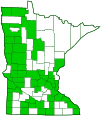tarragon
(Artemisia dracunculus)
Conservation • Description • Habitat • Ecology • Use • Distribution • Taxonomy
Conservation Status |
|
|||||||
| IUCN Red List | not listed |
|||||||
| NatureServe | N5 - Secure SNR - Unranked |
|||||||
| Minnesota | not listed |
|||||||
Description |
||
Tarragon is a 24″ to 60″ tall, erect, perennial forb that rises on a single stem or in a cluster of numerous stems from fibrous roots and a short rhizome or branching caudex. When crushed, the leaves and stem may be either not fragrant to only slightly fragrant or strongly tarragon-scented. The stems are erect or ascending, stiff. They are green at first, later turning brown or reddish-brown and becoming somewhat woody. They are sometimes hairless, usually sparsely to moderately covered with short, curly hairs. Basal leaves are narrowly linear, 2″ to 3⅛″ long, and ⅛″ to 3 ⁄16″ wide. They have a pair, rarely two pairs, of slender, ascending lobes near the base. The leaves and lobes are sharply pointed at the tip. In Minnesota, the upper and lower surfaces are usually bright green and hairless. They are not silvery or whitish in appearance. The margins are untoothed. Stem leaves are alternate, ⅜″ to 2¾″ long, 1 ⁄32″ to 3 ⁄16″ wide, and otherwise similar to basal leaves. Lower, larger stem leaves are sometimes lobed. Middle and upper stem leaves are rarely lobed. Stem leaves do not have leaf-like stipules or stipule-like lobes or teeth at the base. The inflorescence is an open, leafy, 6″ to 18″ long, 2½″ to 11½″ wide, branched cluster (panicle) of numerous, densely spaced flower heads at the end of the stems and branches. The flower head is small and ball-shaped. It is on a slender, very short, sometimes nodding flower stalk. The whorl of bracts at the base of the flower head (involucre) is 1 ⁄16″ to ⅛″ long and wide. On the margin of the disc are 6 to 25 pale yellow florets with both stamens and pistils that are fertile and produce fruits. In the center are 8 to 200 pale yellow florets that also have both stamens and pistils, but have abortive ovaries and do not produce fruits. There is no floral scent. The fruit is a tiny achene. |
||
Height |
||
24″ to 60″ |
||
Flower Color |
||
Pale yellow |
||
Similar Species |
||
|
||
Habitat |
||
Dry. Prairies, roadsides. Full sun. |
||
Ecology |
||
Flowering |
||
July to September |
||
Pests and Diseases |
||
|
||
Use |
||
|
||
Distribution |
||||
|
Sources |
|||
| 5/29/2023 | ||||
Nativity |
||||
Native |
||||
Occurrence |
||||
|
||||
Taxonomy |
|||
| Kingdom | Plantae (Plants) | ||
| Division | Tracheophyta (Vascular Plants) | ||
| Subdivision | Spermatophytina (Seed Plants) | ||
| Class | Magnoliopsida (Dicots) | ||
Order |
Asterales (Sunflowers, Bellflowers, Fanflowers, and Allies) | ||
Family |
Asteraceae (Sunflowers, Daisies, Asters, and Allies) | ||
| Subfamily | Asteroideae | ||
| Supertribe | Asterodae | ||
| Tribe | Anthemideae (chamomiles, yarrows, and allies) | ||
| Subtribe | Artemisiinae | ||
| Genus | Artemisia (wormwoods and sagebrushes) | ||
Synonyms |
|||
Artemisia aromatica Artemisia dracunculina Artemisia dracunculoides Artemisia dracunculoides var. dracunculina Artemisia dracunculus ssp. dracunculina Artemisia dracunculus ssp. glauca Artemisia dracunculus var. glauca Artemisia glauca Artemisia glauca var. dracunculina Artemisia glauca var. megacephala Oligosporus dracunculus Oligosporus dracunculus ssp. glaucus |
|||
Common Names |
|||
dragon dragon sage-wort dragon wormwood false tarragon French tarragon green sagewort silky wormwood tarragon wormwood |
|||
Glossary
Achene
A dry, one-chambered, single-seeded seed capsule, formed from a single carpel, with the seed attached to the membranous outer layer (wall) only by the seed stalk; the wall, formed entirely from the wall of the superior ovary, does not split open at maturity, but relies on decay or predation to release the contents.
Caudex
A short, thickened, woody, persistent enlargement of the stem, at or below ground level, used for water storage.
Involucre
A whorl of bracts beneath or surrounding a flower, flower head, or flower cluster.
Linear
Long, straight, and narrow, with more or less parallel sides, like a blade of grass.
Panicle
A pyramidal inflorescence with a main stem and branches. Flowers on the lower, longer branches mature earlier than those on the shorter, upper ones.
Rhizome
A horizontal, usually underground stem. It serves as a reproductive structure, producing roots below and shoots above at the nodes.
Stipule
A small, leaf-like, scale-like, glandular, or rarely spiny appendage found at the base of a leaf stalk, usually occurring in pairs and usually dropping soon.
Visitor Photos |
|||||
Share your photo of this plant. |
|||||
| This button not working for you? Simply email us at info@MinnesotaSeasons.com. Attach one or more photos and, if you like, a caption. |
|||||
|
|||||
MinnesotaSeasons.com Photos |
|||||
|
|||||


Visitor Videos |
|||
Share your video of this plant. |
|||
| This button not working for you? Simply email us at info@MinnesotaSeasons.com. Attach a video, a YouTube link, or a cloud storage link. |
|||
Other Videos |
|||
| Tarhon, planta, artemisia dracunculus L. Adrian Manolache |
|||
About
Published on May 24, 2014 |
|||

Visitor Sightings |
|||||
Report a sighting of this plant. |
|||||
| This button not working for you? Simply email us at info@MinnesotaSeasons.com. Be sure to include a location. |
|||||
|
|||||
MinnesotaSeasons.com Sightings |
|||||

|
Created: Last Updated: © MinnesotaSeasons.com. All rights reserved. |

